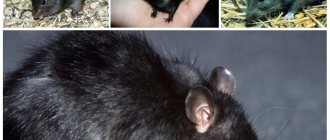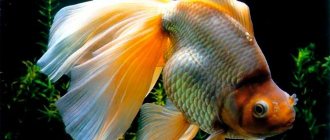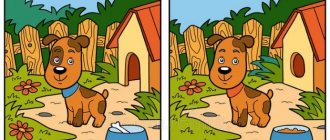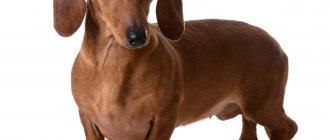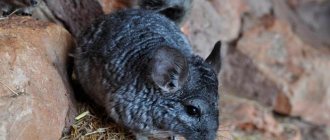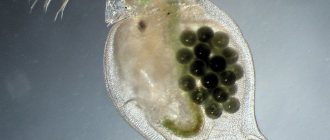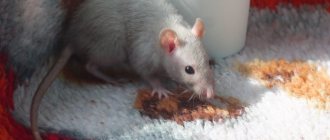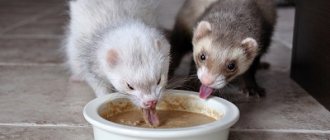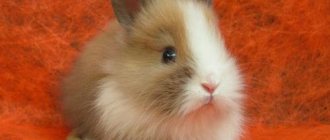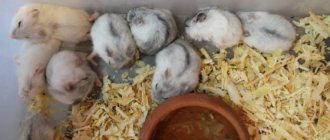Description and features
Choosing a pet among the varieties of dumbo rats will not be difficult. The pups have won recognition for their friendly nature and funny appearance. Animals with big ears are not just cute creatures, they are trainable, sociable, and incredibly smart.
It is easy to distinguish dumbo rat pups from their relatives by the following characteristics:
- the head is wider than that of “relatives”;
- slightly protruding nape;
- pear-shaped body;
- a pointed muzzle with round beady eyes on both sides.
The rounded ears of the rat are set low - this is reflected in the breed standard. The value of each specimen is measured by the size of the ears: the larger, the more expensive the animal. The structure of this organ is of two types:
- “tulip” – petal-shaped, curled, pointed;
- “saucers” - flat, round.
The first type of baby rats, with petal ears, is more common in European countries. If you press the animal behind the ear, the shell opens up like a flower. In practice, pets are chosen not only by their ears, but also taking into account color and species preferences. The tails of animals come in different lengths, the fur depends on the type of rodent.
The decorative rat Dumbo is not inferior to the parameters of its relatives: the weight of an adult male is 300-500 g, body length is 18-20 cm. Females are smaller in size: weight is approximately 250-400 g, length is 15-18 cm.
Eared pets with outstanding breed characteristics are difficult to find. Decorative Dumbo rat pups, although they themselves do not have obvious “ears,” can give birth to offspring according to the conditions of the breed standard.
In captivity, the domestic rat Dumbo quickly gets used to its owner and responds to its name. It is recommended to name pets briefly and sonorously: Bonya, Sonya, Ksyusha, Knopa - females, Pete, Tosha, Garik, Bucks, Rocky - males.
The rodent will perceive the sound of the owner's voice as a call to run towards him. Hand training will help you return your pet to the cage after active games. Young animals are curious and active, older rat pups value peace - they love to sit on laps or shoulders, warming their owner with warmth.
The Dumbo rat is a clean animal, this is manifested in litter box training and daily self-cleaning. Attachment to family members brings harmony to the life of the little creature and those who take care of the dumbo.
More about huge mutant rats
Yet stories of giant mutant rats in the Moscow metro or abandoned military bunkers remain surprisingly enduring. Their phenomenon is easy to explain: people do not want to put up with the dullness of their everyday lives and are willing to believe in almost any unusual and inexplicable phenomena, even frightening ones. After all, these “horror stories” give hope that the world around is not as ordinary and dull as it seems most of the time, and there is certainly a place in it for some mysteries - including mutant rats.
It is also useful to read: The phenomenon of the rat king and interesting facts about this phenomenon
Simply put, people want to believe in the existence of monster rats, and science fiction writers, horror film directors, and rumor mongers simply exploit these fears to their advantage. As a result, more and more new versions of “facts” and “eyewitness accounts” constantly appear, and the old ones are repeatedly altered and turned into more and more new versions, sometimes completely different from the originals.
For example, the stories allegedly told by Moscow metro drivers are very well known. According to them, in the farthest sections of the tunnels, the headlights of trains occasionally reveal huge rats the size of dogs crossing the tracks. Most of these stories are full of chilling details: in that brief moment that a ray of light snatches a rat from the darkness of the tunnel, the animal manages to look at the driver with evil green (in other versions - red) eyes, and then suddenly news appears that these animals no poison works. It is unknown which of the drivers tried to poison these mutants (just as the names of those who actually saw these animals are not known), but most storytellers consider it their duty to mention such immunity.
Also popular is an allegedly real story that happened to a group of Moscow diggers (specialists involved in the study of caves and artificial underground tunnels). In a sewer under the zoo, this team was attacked by five large rats the size of a dog, and the guys were saved only by throwing their crowbars at the animals and in this way scared them away.
This story was continued. They say that an anonymous person later called the diggers club and said that there were a lot of large rats in secret bunkers for storing radioactive waste. It is well known that the more secrecy and conspiracy theories there are in a story, the more popularity it will have...
There are also stories circulating among people about giant rats climbing out of manholes near landfills and scattering dogs there. Moreover, these stories are unusually tenacious: the first reports of such rats appeared back in 1989, and after that their number has only increased.
It is interesting to note that the less believable each particular story is, the more easily it spreads among the people. It is the details that seem fantastic that make such tales “hot”: either huge rats create the most complex organizations with commanders, pioneers and suicide bombers, or they deliberately feed on poisons or winding wires - there are countless such details.
Someone is even trying to mix together rumors about mutant rats and news about the discovery of Bosavi woolly rats. The result is a mix unimaginable for a specialist that, they say, scientists have discovered a new species of giant rats - Indonesian - in the Moscow subway. Why Indonesian? Simply because the name is simpler than “Bosavi woolly rat” or “Papua New Guinea rat.”
We will not waste time refuting such speculation, but will only say that none of these rumors have factual confirmation.
Types of dumbo rats
Among the diversity of species, everyone will find a companion to suit their taste. All animals are interesting in their own way.
Dumbo rex. A distinctive feature of the species is the curly fur. From a distance, the lop-eared rodent resembles a fluffy toy. The animal's curled antennae create a funny look. If you take the animal in your hands, you can see thick and wavy fur, hard to the touch.
Dumbo rex rats come in different colors: tri-color, white, gray, black.
Dumbo sphinx. A win-win option for pet owners with allergies. Rats have no hair. Bare folded skin evokes tenderness and tenderness in the soul towards defenseless animals.
Sometimes sparse hairs are observed on the head, back, and paws. Skin color can be black, white, pinkish, bluish, even chocolate. It is pleasant and silky to the touch. The antennae are small and slightly curled. The appearance of hairless rat pups is associated with the action of mutated genes.
Dumbo Siamese rats. The self-explanatory name reflects the color feature characteristic of Siamese cats. The tail, paws, and muzzle, painted in dark tones, contrast with the whitish coat on the rodent’s body.
The offspring of Siamese rat pups may not get the same colors. Unlike other species, the nature of the animals is capricious with aggressive manifestations. It is not recommended to have a pet for small children.
Dumbo Husky. A rare breed of rodents, also called chameleons. The name is borrowed from a famous dog breed. It is noteworthy that babies of this species are born in the usual colors: white-gray, brown, black. Over time, growing pups change their fur coat to a new one, diluted with snow-white touches.
Manx. A species of tailless animals obtained as a result of gene mutation. When purchasing this species, you can be deceived by dishonest sellers who offer ordinary animals with docked tails after birth.
Blue mink. A rare breed that is difficult to find. The name conveys the characteristic color of a delicate blue hue.
The color and structure of the fur of rats of the same species may vary. The fur is often straight and velvety, less often curly or satin, when only the muzzle is covered with long hairs. In addition to traditional colors (gray, brown, black), there are rare animal colors - mosaic, topaz, amber.
Types and breeds of decorative rats
There are different types of pet rats that, when handled correctly, become tame. Depending on the type of coat, animals are standard, satin, curly, or sphinx. The average weight of adult males is from 400 to 650 grams, and females - 250-450 grams.
Pet rats
Standard
Domestic standard breed rats are characterized by a proportional build. They are slender and agile animals. At the top of the head there are small, proportional ears. The entire body of the rodent has shiny fur that adheres to the skin. The hair on the legs and tail is short.
Light-colored animals have velvety fur on their ears. There are whiskers above the eyes and on the cheeks. If the rodent has a different type of fur, the whiskers may be short and curled. Decorative rats of the Standard breed are one of the largest rodents, weighing up to 500 grams.
Dumbo
Rats of this breed differ in the structure of their skull. The ears are round in shape and located in the middle part of the head, which is slightly flattened.
Dumbo breed
Dumbo animals have completely open ears. In some individuals they are slightly bent at the edges. Some specimens have a slightly protruding nape. From behind, the animal has an extended body shape.
Rex
Rex are animals that have curly and hard hair. There are short curling antennae on the cheeks.
The Double Rex species of decorative rats appears in parents with curly fur. The skin of such animals is dotted with areas of hard guard hair or down. Shedding is a feature of the breed. After birth, the pet loses its fur and bald spots appear in patches. After this, the fur grows, and in those places where it was, it falls out.
For your information! This species has no official name.
Sphinx
This is a type of domestic rat that has no fur at all. In some cases, there is a small fluff in the groin area, paws and head. Rodents have pink skin with visible folds. Some individuals have black spots on their skin.
Sphynx breed
Satin
Satin animals have thin and shiny fur. The attractiveness of rodents is ensured by the shine of their fur coat. Some satin pets have short hair, like standard animals.
Tailless
The animal has a telling name. His tail is completely missing. The body has a pear-shaped shape, which distinguishes the animals from other species. Animals without a tail are active and intelligent. Rodents have curly or standard coats of different colors. Some individuals have no hair at all.
Tailless rat
Manx
Manx rats are characterized by the absence of a tail, which is why they are classified as disabled rats. Most of these animals have diseases of the urinary system and hind legs. The fur of the animals is straight or curly, the color is different.
Other breeds of decorative rats
Among the interesting breeds of decorative pets are the fuzz. In appearance they are similar to sphinxes. There is only fluff on the skin, and there are no guard hairs. Long-haired rats are similar in appearance to standard rats, but have a longer coat.
Care and maintenance at home
Caring for tame animals is not difficult. They take up very little space, and caring for dambos does not require any expense. To ensure a comfortable existence for pets, you should take into account some features of the life of eared babies.
Dumbo rats are inquisitive and intelligent. They are superior in intelligence to hamsters and guinea pigs. They waddle like penguins. Their physique does not allow them to run fast, but the animals take walks and mark their territory.
Owners need to take into account that while traveling around the house, rodents will taste everything they come across on the way. Walks must be supervised; animals spend most of their time in cage houses.
Housing for one pet can measure 60 cm in width, length and height. An open aquarium is not suitable, as animals can get out of it. High jumping half a meter is not a record for them. A wire cage with a plastic tray and shelves will be especially cozy if you put a house in it for a relaxing holiday.
Rodents love to be alone and feel protected. The bottom is covered with wood filler; sometimes napkins are spread underneath for ease of cleaning. It is preferable to use shavings, not sawdust, which enter the animal's respiratory tract.
Hanging cups and nipple drinkers must be installed at a sufficient level taking into account the size of the pet. Dry and liquid food are placed in different bowls. A separate corner is allocated for a tray with filler. They won’t let your pet get bored and provide daily loads of stairs, a hammock, and a tunnel.
It is recommended to install the cage with your pet on a small hill up to 1 m from the floor. It is better to choose a place away from bright light and radiation sources. It is important to provide protection from drafts, loud sounds, overheating or hypothermia.
The temperature comfortable for pets should be about 20°C, air humidity 50% or more. On hot days, spraying the home or a container of water near the cage helps combat dryness, which is harmful to the breathing of rat pups.
To ensure full life support for pets, several rat pups are bred. Same-sex individuals will not be bored; opposite-sex individuals will bear offspring.
The cage is cleaned as needed, 1-2 times a week. The appearance of an unpleasant odor is a signal to disinfect the home. Removing food residues and replacing litter will help maintain the sanitary condition of the home, which affects the pet’s well-being.
Dumbo rats hygienic procedures independently - they wash themselves and clean their fur. Help is required in regularly shortening growing claws. It is recommended to occasionally bathe pets in heated water. For the fur you need a special shampoo from the pet store.
The Dumbo rat does not like the intrusive attention of household members; communication with other pets should be limited. At the same time, it is a social animal, capable of appreciating communication with humans, becoming attached to its owner, and showing boundless trust in those who show it care and affection.
Training in the form of a game brings joy to the animal, which can learn to find a treat, overcome barriers, and fetch objects. Weasel makes the little rat a loyal and affectionate companion.
How big are sewer rats and are there giant mutants among them?
In Russia, two types of rats live next to people, in attics, basements and in the sewers of their houses - gray (pasyuk) and black. They are similar to each other, but the gray one is larger: the body length of adult individuals of this species can reach 25 cm (excluding the length of the tail), and the weight is 400 grams. However, gray rats usually do not grow even to the size of a cat.
The photo below shows a gray rat:
And here it is black:
Black rats are smaller than gray ones: the largest individuals of this species reach a length of 22 cm from the tip of the nose to the base of the tail, and their weight rarely reaches 300 grams.
Pasyuk, the larger one, is exactly that sewer rat that willingly inhabits sewers, damp basements and basement floors. The black rat prefers to live in dry rooms and attics. Other types of rats have never been discovered in the Russian urban jungle, and stories that huge rats the size of dogs live in the Moscow metro are so far just unconfirmed rumors (however, we’ll talk about huge “mutant rats” a little lower ).
And in general, the biggest rat in Russia is still the same pasyuk. The fact is that all representatives of the rat genus are heat-loving; in temperate or cold climates they can only live next to humans. In the wild in the south of our country, only black rats live, which are inferior in size to gray ones, and larger species are known only from tropical regions. That is, even in the Siberian wilderness or in the endless steppes of southern Russia, huge rats are not found.
Nutrition
Rats eat almost everything, but the wrong food leads to diseases and allergies. Pets are especially susceptible to eating disorders.
A balanced diet includes:
- dry food, including millet, barley, oats, flax seeds, pumpkin;
- chicken, fish meat;
- dairy products: kefir, cottage cheese;
- greens in the form of dandelion leaves, parsley, dill;
- fruits: pear, banana (except unripe ones), plum.
Treating yourself to nuts will help grind your teeth. Sometimes animals can be pampered with dried fruits. Undesirable foods in the diet are:
- beet;
- cucumber;
- turnip;
- cheese (especially blue cheese);
- eggs;
- sour cream.
They can be offered in limited quantities no more than once a week.
Products strictly prohibited for consumption:
- sausages;
- sweets, including chocolate;
- spinach;
- raw potatoes;
- beans;
- rhubarb;
- cabbage.
Walking around the house is dangerous for pets due to encountering potted plants:
- Kalanchoe;
- Dieffenbachia;
- geranium;
- ivy;
- begonia;
- cyclamen;
- hydrangea;
- aloe;
- hydrangea.
It is important to monitor the freshness of the water in the drinking bowl and change it every day. Babies are fed 4 times a day, adult rats - 2 times.
Aging of rats
Dark red-brown deposits around the eyes, hair loss, and orange scales in the coat are typical signs of aging in rats.
From the 15th month of life, signs of aging appear in the form of problems with teeth and heart function, liver and kidney diseases. Symptomatically, this usually manifests itself in the form of tousled hair, dehydration, sticky eyelids and vestibular disorders.
Therapeutically, it is possible to help by making it easier to combat individual symptoms through a balanced diet and adequate supply of vitamins.
Reproduction and lifespan
Young rat pups become sexually mature by 6 months. To produce offspring, animals with distinct species characteristics are needed. Pregnancy lasts 21-23 days. There are 8-12 babies in a litter. Rats are born blind, deaf, and naked. Not all newborns have large ears.
The development of the young is rapid. At 4 days the babies begin to hear, at 12 days they begin to see. When babies are 14-15 days old, they are ready to explore the world and communicate with people. From three weeks of age, Dumbo rats feed on adult food. At one and a half months, the pups are completely independent.
How long dumbo rats live depends largely on the conditions of their detention. The average life expectancy is 2-3 years. Caring for pets, proper care, timely treatment of diseases and a balanced diet prolong the life of decorative rats up to 4-5 years.
Artificial feeding of rats
If the female is sick or has behavioral disorders, you can try to raise the babies yourself.
In the first stage, a red light source or a warm pad as a heat source is important. Rat milk contains 9.7% protein, 13% fat and 3.2% milk sugar. As a milk substitute, you can use a mixture of 100 ml of coffee cream and egg white from a medium-sized egg. When the young animals begin to feed on their own, you can add boiled potatoes, greens or ready-made baby food to the milk replacer; feed until the animals begin to eat adult food on their own. Tags: maintenance, feeding, care, problems, diseases, rat
Price
You need to purchase a purebred rat from trusted breeders so as not to be deceived by scammers. The Dumbo rat in the photo in the online store may be purebred, but the purchased specimen may turn out to be an ordinary decorative animal.
A guarantee of thoroughbredness can only be obtained in a specialized nursery. The price depends on many factors: rarity of the species, conditions of detention, purchase price, etc.
Specimens that appear due to a genetic failure become unique. In nature, such individuals do not survive, for example, albino rats. The cost of such animals is above average.
The price for one dumbo rat varies from 200 to 3000 rubles. Buying any pet is not just fun, but also a responsibility for a small eared miracle that brings the joy of communication.
